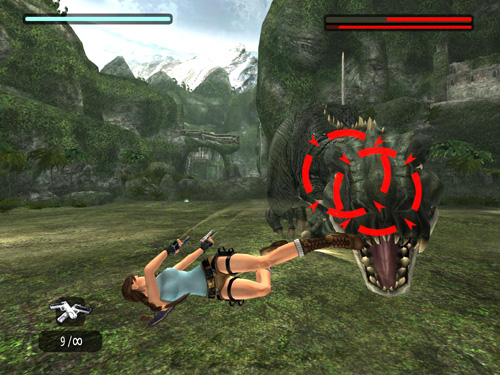It so happened that a few months ago I was showing my friend the Tomb Raider game that was released last year (TR9). I kept on playing even after he left and in a few days I had completed the game (again). This time I was playing with a controller instead of the usual keyboard + mouse combo, so the experience was considerably different from the last time I had done so.
I thought to myself how would the experience of using a controller be for older Tomb Raider games.I took out my Tomb Raider Anniversary (TRA) disc and played through the entire game in about two weeks (Oh! I have a day job whose priority is higher than playing games). What I realised was that TRA was easier to play using a controller than the usual K+M combo. Specifically, a move such as “Adrenaline Dodge” is too difficult to perform on the keyboard. I remember the last time I played TRA, it took me considerable time to defeat the final boss. In general, it is impossible to defeat any of the bosses without the usage of this maneuver, so in a way, this run-through was a breeze.

The experience was same while playing through Underworld (TR8). There is a sense of fluidity when using a controller. I believe TR7/8/A/9 were made while keeping this in mind. On a side note, if you are trying to play Lara Croft: Guardian of Light (LCGOL) using a keyboard, I’ll give you props for that. The isometric view of playing field requires a lot of diagonal motion, i.e. pressing two direction keys simultaneously. As a result, I have never played it using a K+M combo.
The older TR games were made for PS and Sega systems. The PC version doesn’t have native support for a modern controller (I forgot to mention – I use an XBOX 360 controller on my Win7 machine). I tried mapping the keys using xpadder. But somehow, the fluidity was lost. I started playing The Last Revelation (TR4) using the X360 controller but soon moved to keyboard (no mouse support). To my surprise, it felt much better. The controls were precise. Maybe, the grid based game design of older TR games favours the usage of discrete direction. Maybe, the D-Pad would be better as a navigation input that the joystick of the X360 controller. I should try it on TR1*.
Controller dependency aside, there was something else that I had realised while playing through these games. The more expansive it is, the more enjoyment I get out of the game. Amongst all the five titles I had re-played, TR4 was my favourite**, folowed by TRA, TR9, TR8 and finallyTR7 (Legend). TR8 and TR9 were close in terms of enjoyment but TR9 had better gameplay mechanics. TR4 and TRA (as well as TR1 from which TRA is derived) both are massive in terms of game levels. There are a lot of puzzles and it is easy to get stuck. This is where TR9 lost some steam. Sure it has amazing graphics, fluid controls and an above average story, yet, somewhere that sense of discovery and achievement is lost. This may not be true for someone who has a short attention span.
Notes:
*For those who wish to run TR1 on Win7 machines, I would suggest grabbing a PS1 Tomb Raider 1 disc and playing it using ePSXe (or any other working PS1 emulator). Playing the DOS version of Tomb Raider 1 on modern machines is really a challenging task. I have a slipstreamed version of PC TR1 that can run using DosBox. Still I have trouble getting the audio to work.
**TR3 is my absolute favourite, followed by TR1, TR4, TR2, TRA, TR9, TR8, TR7, TR5 and finally TR6.

